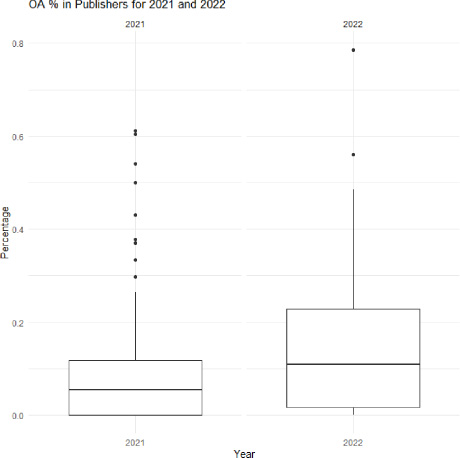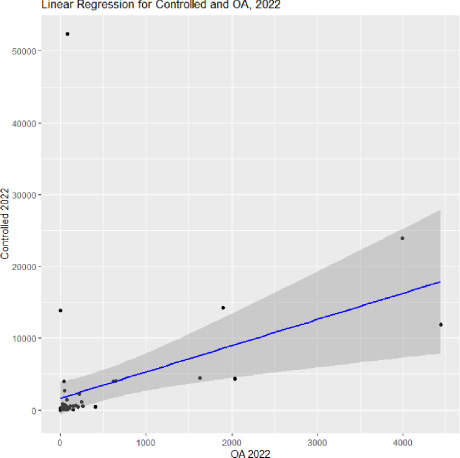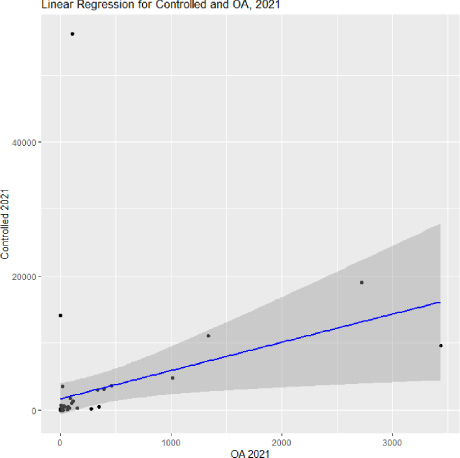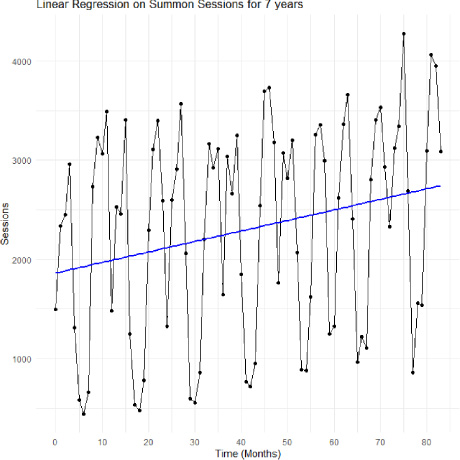Open access and COUNTER usage: Hybrid OA impact on a Private Liberal Arts College
Abstract
The popularity of open access (OA) publications has increased in recent years. This situation leads to several pertinent questions for academic libraries: Is the rapid expansion of OA availability negatively affecting their COUNTER usage reports? And, as a consequence, is the increasing accessibility of OA publications prompting academic libraries to reconsider their subscriptions to traditional, subscription-based resources? The primary objective of this paper is to investigate the impact of hybrid OA growth on Denison University’s subscribed e-resource usage and to illuminate the potential effects of OA on academic library subscriptions.
1.Introduction
The popularity of open access (OA) publications has increased in recent years. While there is still ongoing debate over the true impact of OA on scholarly communication, the continued growth of OA publications worldwide cannot be denied. However, there is a challenge in accurately measuring the impact of OA resources in academic libraries since some OA platforms (such as ArXiv, Sci-Hub) do not share COUNTER usage reports with academic libraries.
This situation leads to several pertinent questions for academic libraries: Is the rapid expansion of OA availability negatively affecting their COUNTER usage reports? And, as a consequence, is the increasing accessibility of OA publications prompting academic libraries to reconsider their subscriptions to traditional, subscription-based resources? While it is not feasible to evaluate the usage of all OA platforms within the Denison community, this paper aims to address these questions by examining COUNTER TR_B3 and TR_J3 reports collected by Denison University Libraries. These reports reveal the usage of paywalled and hybrid OA resources, offering valuable insight into the matter at hand.
The primary objective of this paper is to investigate the impact of hybrid OA growth on Denison University’s subscribed e-resource usage and to illuminate the potential effects of OA on academic library subscriptions.
2.Literature review
Open access (OA) is a growing trend in scholarly communication. Solomon et al. [1] found that 11% of journals published in Scopus were assumed to be OA in 2013. Per Piwowar et al. [2], at least 28% of the scholarly literature is OA, with the proportion of OA articles increasing over time. Curtin Open Knowledge (n.d.) [3] shows that in the United States, the OA percentage is 54% in 2022.
Although it is great that many research articles are now open, OA may not necessarily help researchers in developing countries. Ellers, Crowther, and Harvey [4] found that the costs of Article Processing Charges (APCs) for open access mega-journals are disproportionately borne by developing countries compared to Western countries. Beall [5], the creator of the Beall’s list, famously pointed out the Gold OA model was “failing” (p. 8), due to its publishing structure that financially rewards more paper acceptance and charges high APCs, which is a characteristic of predatory publishers. The Open Access Scholarly Publishing Association or OASPA [6] reports that OA articles published by OASPA members have grown twentyfold over the past decade, with MDPI, Springer Nature, and Elsevier collectively accounting for fifty-two percent of OASPA members' output, underscoring their dominant presence in the OA publishing landscape.
3.Methods
This study uses COUNTER TR_B3 and TR_J3 reports to assess the impact of hybrid OA readership on the Denison campus. COUNTER TR_B3 is a usage report that provides a summary of ebook usage, broken down by month, title, and access type, which are paywalled (“Controlled” in COUNTER 5 [7]) or OA (“Gold_OA” in COUNTER 5). TR_J3 is a similar report that provides a summary of journal usage, also broken down by month, title, and access type. These reports are useful for tracking usage of both subscription-based and OA electronic resources on campus.
In this paper, hybrid OA usage refers to eJournal and eBook usage that are recorded as Gold_OA iusage n COUNTER 5’s terms, by publishers to which Denison subscribes. COUNTER TR_J1 and TR_B1, were not used for this study because they exclude Gold_OA.
Since Denison rarely receives COUNTER TR_B3 or TR_J3 reports from fully-OA platforms such as ArXiv, the COUNTER usage reports analyzed are hosted by publishers that publish both OA and paywalled resources.
To assess COUNTER TR_B3 or TR_J3 reports, the metric used was unique_item_requests, which is defined as "the number of unique content items (e.g., chapters) requested by a user” (Mellins-Cohen, n.d.) [8].
Denison Libraries have subscriptions to one hundred and ninety-seven publishers; unfortunately, not all publishers provide COUNTER TR_B3 or TR_J3 reports to Denison. Also, since the collection and calculation of COUNTER TR_B3 or TR_J3 usage were conducted automatically using JavaScript, publishers that did not provide SUSHI were excluded. For eJournal study, fifty-three publishers were included, and for eBook study, twenty-four publishers were included.
Fiscal year 2021 (July 2020–June 2021) and fiscal year 2022 (July 2021–June 2022) COUNTER TR_B3 or TR_J3 reports were used for this study. Fiscal year 2020 (July 2019–June 2020) was excluded because not many publishers were ready for COUNTER 5 reports in 2019.
Denison University resumed in-person learning in Fall 2020 and does not offer a summer semester. As a result, the COVID-19 lockdown from Spring 2020 to Summer 2020 should not have had an impact on the COUNTER usage data used in this study, which covers July 2020 to June 2022.
Denison is a fully-residential campus, meaning that its student body lives on campus for four years of their undergraduate education.
4.Results
4.1.eJournal usage
In fiscal year 2021, Denison’s TR_J3 report reveals that Denison's Gold_OA usage, represented by the total number of Gold_OA unique_item_requests, was 11,311. The combined total of Controlled and Gold_OA for 2021 was 149,160. Consequently, 7.6% of the eJournal usage recorded in TR_J3 was OA.
In fiscal year 2022, Denison’s TR_J3 report indicates that Denison's Gold_OA usage, represented by the total number of Gold_OA unique_item_requests, was 18,186. The combined total of Controlled and Gold_OA for 2022 was 171,717. As a result, 10.6% of the eJournal usage recorded in TR_J3 was OA.
Comparing the Gold_OA results from 2021 and 2022, the increase in OA readership at Denison was 6,875, reflecting a 60.78% increase. The usage of Controlled (paywalled) materials increased by 11.4%.
The overall eJournal usage (Gold_OA and Controlled) increase was 15.1% in 2022.
Figure 1 displays the boxplots of OA percentages for all fifty-three eJournal publishers. Some publishers have a very high OA readership % in usage (one publisher had almost 80% OA readership), while some had 0% OA readership. The median OA percentage for the fifty-three publishers for 2022 was 10.9%, while the median for 2021 was 5.5%, indicating OA readership percentage growth. This graph illustrates the growing OA percentage at Denison over the two-year period.
For both 2021 and 2022, the majority of OA_Gold usage originated from two publishers: Elsevier and SpringerNature. Together, they accounted for 54.4% and 46.4% of the total Gold_OA in 2021 and 2022, respectively.
Fig. 1.
eJournal OA percentages, 2021 and 2022.

Figures 2 and 3 visually represent the correlation between the “Controlled” and “OA” downloads (unique_item_requests) in eJournal usage. The points on the graphs correspond to individual data points, with the x-axis displaying the unique_item_requests for the “OA” and the y-axis showing the unique_item_requests for the “Controlled” for each publisher. The solid linear regression line in the plot indicates a positive correlation between the two, suggesting that as the value of the “OA” increases, the value of the same publisher's "Controlled” tends to increase. The shaded area around the regression line represents the confidence interval for the linear regression, providing an estimate of the uncertainty associated with the regression line. These figures were generated using R.
Figures 2 and 3 suggest that major commercial publishers with large usage in paywalled articles tend to have a strong presence in OA usage; as the more usage a publisher has in Controlled (paywalled), the more usage it tends to have in OA. These findings confirm the trend that major commercial publishers are leading the increase in hybrid OA usage at Denison.
In summary, an increase in subscribed eJournal usage in 2022 was observed, suggesting that the Denison community is not reading library subscribed eJournals any less, but as a matter of fact, Denison community is reading more subscribed eJournals. Our publishers experienced an increase in overall usage collectively, with faster growth in hybrid OA readership. No negative correlation was observed between hybrid OA and Controlled. These results indicate that hybrid OA usage is not detrimental to Controlled (paywalled) usage; instead, they tend to grow in tandem as they exhibit a positive correlation. Therefore subscription eJournals are unlikely to be canceled solely based on increased OA usage.
Fig. 2.
eJournals 2022. Controlled = 1642.72 + 3.65 ∗ OA, P-value: 0.0034, Correlation coefficient (r): 0.4.

Fig. 3.
eJournals 2021. Controlled = 1702.26 + 4.21 ∗ OA, P-value: 0.02168, Correlation coefficient (r): 0.31.

4.2.eBooks
Analyzing eBook usage is challenging due to the limited number (twenty-four) of publishers included in this study and the relatively smaller size of eBook usage compared to eJournals, making it difficult to discern general trends.
In 2021, there were a total of 48,991 downloads (unique_item_requests) for both Controlled (paywalled) and Gold_OA combined, which decreased by six percent in 2022 to 46,091 downloads. Additionally, the eBook's controlled usage decreased by 11.7%. Overall eBook usage decrease was also observed when the author used unique_title_requests instead of unique_item_requests.
Denison uses Summon [9] for library resource discovery, and its usage is tracked by Google Analytics. Over the course of the past seven years (Fig. 4), the correlation between the number of monthly Summon user sessions and time (eighty-four months) is statistically significant, indicating as the time passes, the number of user sessions tends to increase. If we think of increasing Summon usage in the past seven years as our community’s continuing interest in library resources, the eBooks usage decline should warrant further investigation.
Regarding Gold_OA usage, less than ten hybrid publishers recorded Gold_OA eBook usage, with a total of one hundred and sixty-nine downloads (unique_item_requests) in 2021 and 302 downloads (unique_item_requests) in 2022. Although Gold_OA eBook usage increased, the result indicates that hybrid OA eBooks are not as common as hybrid OA eJournal articles. The same trend was observed when using unique_title_requests as an alternative metric.
Using R, the results of the linear regression analysis, with Controlled (paywalled) values as the dependent variables and Gold_OA values as the independent variables, showed no statistically significant correlation between OA and Controlled usage for both 2021 and 2022.
The eBook results show that there’s no meaningful relationship between Controlled (paywalled) and Gold_OA in eBook usage for 2021 and 2022. It is unclear if larger commercial publishers with a large number of Controlled (paywalled) usage also attract hybrid OA usage or not.
It is important to note that eBooks in general are not as discoverable as eJournal articles. As Grimme and et al. pointed out, “most monographs do not have DOIs or freely available metadata” (2019) [10], and finding and using eBooks online might take more time and effort than finding eJournal articles. Further research is needed to assess if Denison readers are having a difficult time finding and using eBooks, and if so, what could be done to improve their discoverability and usability.
Fig. 4.
Summon session monthly usage, 2016--2022.

5.Conclusion
At Denison, eJournal usage has seen an increase for both hybrid OA and paywalled articles. There is a positive correlation between hybrid OA and paywalled readership as evidenced in the linear regression analysis for ejournals, suggesting that large commercial publishers with high paywalled usage also tend to have a strong presence in hybrid OA usage. Consequently, it is crucial for librarians to promote awareness of high-quality publications by smaller publishers among students and researchers. These publishers often have a weaker presence in both OA and online environments and may experience limited or no growth in OA readership. As more OA resources become accessible through discovery layers and the broader internet, smaller publishers could face challenges in maintaining a presence within the scholarly journal landscape. Librarians, through their efforts in raising awareness of smaller publishers, can play a vital role in ensuring that diverse sources of knowledge remain accessible to students and researchers.
The numbers of eBooks and publishers analyzed in this study were small, and the correlation between hybrid OA eBook usage and paywalled eBook usage in TR_B3 reports is unclear. However, Denison’s TR_B3 reports witnessed an overall dip in eBook usage in 2022, while hybrid OA usage increased. The reason for this overall usage decline is unclear, and further research into eBook discoverability and usability is needed.
Academic librarians have very limited information about the usage of certain OA publications, such as those from ArXiv and Sci-Hub, within their campuses. However, this study aimed to demonstrate that COUNTER’s TR_B3 and TR_J3 reports can provide valuable insights into hybrid OA usage on campus. The finding reaveal that hybrid OA readership is indeed on the rise at Denison.
At Denison, it appears that the community maintains a continued interest in library resources, as suggested by the increase in eJournals and Summon usage. Despite the fact that many scholarly publications are now published as OA, this does not seem to prevent our community from discovering resources via our discovery layer and utilizing library-subscribed resources. Nevertheless, the decline in eBook usage is concerning; more data needs to be collected to better understand the usage trends in eBooks, and more library instruction regarding eBooks may be beneficial.
About the author
Yuimi Hlasten is the E-Resources and scholarly communications librarian at Denison University in Granville, OH, U.S A where she has worked since 2018. She holds a Master of Library and Information Science from the University of Pittsburgh (2004) and received her Bachelor of Arts degree from Okayama University, Japan (1999). She is the Japanese translator for the Release 5.1 COUNTER Friendly Guides, which were published in 2023 by Project COUNTER. Her interests include metadata, open education, and institutional repositories. E-mail: [email protected].
Additional Reference
Davis, P.M. (2011). Open access, readership, citations: A randomized controlled trial of scientific journal publishing. The FASEB Journal 25(7), 2129–2134. doi:10.1096/fj.11-183988, accessed September 19, 2023.
References
[1] | D.J. Solomon, M. Laakso and B. Björk, A longitudinal comparison of citation rates and growth among open access journals, Journal of Informetrics 7: (3) ((2013) ), 642–650. doi:10.1016/j.joi.2013.03.008, accessed September 19, 2023. |
[2] | H. Piwowar, J. Priem, V. Larivière, J.P. Alperin, L. Matthias, B. Norlander , The state of OA: A large-scale analysis of the prevalence and impact of Open Access articles, PeerJ 6: ((2018) ), e4375. doi:10.7717/peerj.4375, accessed September 19, 2023. |
[3] | Curtin Open Knowledge Initiative. (n.d.). United States. https://open.coki.ac/country/USA/, accessed September 19, 2023. |
[4] | J. Ellers, T.W. Crowther and J.A. Harvey, Gold open access publishing in mega-journals: Developing countries pay the price of western premium academic output, Journal of Scholarly Publishing 49: (1) ((2017) ), 89–102. doi:10.3138/jsp.49.1.89, accessed September 19, 2023. |
[5] | J. Beall, Predatory publishing is just one of the consequences of gold open access, Learned Publishing 26: (2) ((2013) ), 79–84. doi:10.1087/20130203, accessed September 19, 2023. |
[6] | OASPA. (2022, Dec 19). OASPA members’ output in fully OA journals is accelerating. https://oaspa.org/oaspa-members-output-in-fully-oa-journals-is-accelerating, accessed September 19, 2023. |
[7] | COUNTER. The COUNTER Code of Practice for Release 5, https://www.projectcounter.org/code-of-practice-five-sections/4-1-usage-reports/, accessed September 19, 2023. |
[8] | Mellins-Cohen, T. (n.d.). The Friendly Guide to Release 5 for Librarians. http://www.projectcounter.org/wp-content/uploads/2018/03/Release5_Librarians_PDFX_20180307.pdf, accessed September 19, 2023. |
[9] | See: https://exlibrisgroup.com/products/summon-library-discovery/, accessed September 19, 2023. |
[10] | S. Grimme, M. Taylor, M.A. Elliott, C. Holland, P. Potter and C. Watkinson, The State of Open Monographs, 2019. doi:10.6084/M9.FIGSHARE.8197625.V4, accessed September 19, 2023. |




